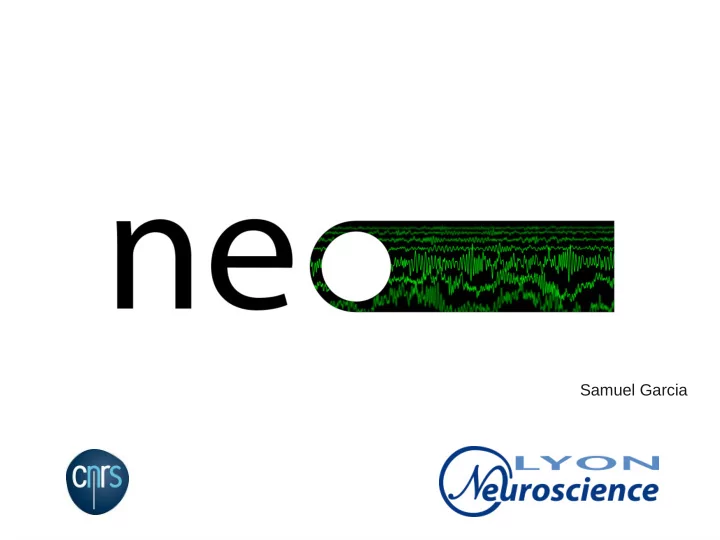

Samuel Garcia
neo : a 100% code jam project! History : ● Discussions started in Freiburg 2009 (codejam #3) : Pierre Y., Andrew D, Luc E., … ● Neo 0.1 release some mouth. Coded almost alone. ● Neo 0.1 presented in Marseille 2010 (codejam #4) ● And New discussion for neo 0.2 : Andrey S, Philipp R, Andrew D, Florent J, … ● Private code jam with new team in Gif at Andrew's lab last year. ● Released on feb 2012. neo 0.2 ● Presentation Edinburgh 2012 (codemjam #5)
What is neo ? neo.core = a simple and intuitive set on objects for representing electrophysiological dataset in python. neo.io = a common layer for reading/writing in the cacophony of file formats. Goals ? What are main interests : ● Interoperability between projects (g-node, pynn, OpenElectrophy, NeuroTools, ...) ● A 5 min. installable, multiplatfrom, and easy to play file reader. Dependencies ? Few = numpy and quantities Optional for some IOs = pytables , scipy, Equivalent project ● Neuroshare (ddl provide commercial) ● for neuro imaging: nibabel (python)
What is new ? ● new schema more consistent. ● new objects ● New IOs ● use the quantities module for everything that can have units. ● Python 3 support ● better tests ● Doc with better English grammar.
Class tour
Class tour: Concept 3 types of objects: ● Data objects : AnalogSignal, SpikeTrain, EventArray, EpochArray ● Containers objects : Block, Segment ● Grouping objects : RecordingChannel, RecordingChannelGroup, Unit (ex Neuron) All object have 3 types of attributes: ● Required (AnalogSignal.sampling_rate, AnalogSignal.t_start, ...) ● Recommended (AnalogSignal.name, ...) ● Free in annotations dict: SpikeTrain, AnalogSignal, and AnalogSIgnalArray inherits python-quantities:directly behave like np.array with units.
Class tour: schema
Class tour : definition AnalogSignal: A regular sampling of a continuous, analog signal. AnalogSignalArray: A regular sampling of a multichannel continuous analog signal. ( 2D NumPy array) Spike : One action potential characterized by its time and waveform. SpikeTrain: A set of action potentials (spikes) emitted by the same unit in a period of time (with optional waveforms). Event and EventArray: A time point representng an event in the data, or an array of such time points. Epoch and EpochArray: An interval of time representing a period of time in the data, or an array of such intervals. Segment: A container for heterogeneous discrete or continous data sharing a common clock (time basis) but not necessarily the same sampling rate, start time or end time. A Segment can be considered as equivalent to a "trial", "episode", "run", "recording", etc., depending on the experimental context. May contain any of the data objects. Block: The top-level container gathering all of the data, discrete and continuous, for a given recording session. Contains Segment and RecordingChannelGroup objects. RecordingChannelGroup: A group for associated RecordingChannel objects. This has several possible uses: RecordingChannel objects of the same array. Unit: A Unit gathers all the SpikeTrain objects within a common Block, possibly across several Segments, that have been emitted by the same cell. A Unit is linked to RecordingChannelGroup objects from which it was detected. This replaces the Neuron class in the previous version of Neo (v0.1).
Class tour : Use case
Class tour : Use case
IO tour First interest to have same classes : Same API to read/write data files. All formats are really different so we need a flexible API: ● ABF = Block+Segment+AnalogSignal+Event ● Plexon = Segment+SpikeTrain+Spike+AnalogSignal ● PyNN = SpikeTrain+AnalogSignal ● RAW = AnalogSignal What is this API ? ● For each format you have an IO class ● The IO class can read or write one or several neo objects.
IO : tour
IO tour : workflow One class per format: Different modes (file, dir, database, ...) Examples
IO tour : workflow Concept of readable/supported objects: Class offer reading method for readable objects All classes propose read() = read_block()
IO tour : workflow Cascade option: Lazy option:
Projects on top of neo OpenElectrophy Web portal for benchmarking spike sorting algorithm At G-Node (Felix Franke, Andrey Slobodev) New NeuroTools Mozaik PyNN
Conclusion ● If your project generate data : write an IO for neo ● If your project manage signals and spikes : provide an interface to neo objects ● If your experimentalist colleague wants to read data set from commercial systems: neo.io
Thanks to the the neo team Samuel Garcia Andrew Davison Chris Rodgers Pierre Yger Yann Mahnoun Luc Estabanez Andrey Sobolev Thierry Brizzi Florent Jaillet Philipp Rautenberg Thomas Wachtler Cyril Dejean Thanks to Michael Hanke to make the very first debian package of my life.
Recommend
More recommend